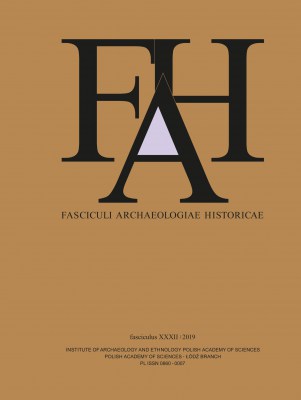 Fasciculus 32 2019
Fasciculus 32 2019
Fasciculi Archaeologiae Historicae 32/2019
Informacje bibliograficzne
Czasopismo: Fasciculi Archaeologiae Historicae XXXII
Redaktor: Jerzy Maik
Wydawca: Institute of Archaeology and Ethnology Polish Academy of Sciences
Miejsce: Łódź
Rok wydania: 2019
Język: angielski
Liczba stron: 244
Format: A4
Okładka: miękka
ISSN: 0860-0007
Opis
Tematyką, zgodnie z tytułem czasopisma, jest tzw. archeologia historyczna, od starożytności po czasy nowożytne. Preferowane są zagadnienia związane z historią uzbrojenia i dawnej wojskowości, od lat będące jednym z głównych tematów badań uprawianych w Oddziale Łódzkim Instytutu Archeologii i Etnologii Polskiej Akademii Nauk. Innymi, wiodącymi tematami są m. in. architektura, zwłaszcza architektura militarna, numizmatyka, człowiek i natura oraz historia włókiennictwa. Od kilku lat artykuły są tak dobierane, aby każdy zeszyt mógł otrzymać indywidualny tytuł.
Spis treści
ARTICLES
Kalina Skóra With or without Respect? Treatment of Post-mortem Remains of the Dead in the Course of Post-funeral Interferences
at Czarnówko in Pomerania
Marcin Majewski The Bones Have Been Cast. Away. The Attitude of Inhabitants of Chartered Stargard to the Remains of
Their Predecessors from Early Middle Ages
Tomasz Kozłowski, Małgorzata Grupa Cognitive Values of Ossuaries from the Cemetery and the Church of St. Nicholas in
Gniew, Poland
Marek Dworaczyk Gefäßkeramik als Mittel zur Datierung und zur Bestimmung der Nutzungsdauer eines Siedlungsbefundes
am Beispieldes frühmittelalterlichen Burgwalls von Lubin
Felix Biermann, Katrin Frey Monastic Waste Disposal in the Late Middle Ages – a Subaquatic Debris and Garbage Dump
at the Lakeside Lavatoryof Seehausen (Uckermark)
Andrzej Janowski Zero Waste. Some Remarks About Copper Alloy Bowls Recycling in the High and Late Middle Ages
Beata Wywrot-Wyszkowska Die Wiederverwertung der Rohstoffen und die Verwaltung von Produktionsabfällen in
spätmittelalterlichenOstseestädten im Spiegel archäologischer Quellen. Einige Bemerkungen am Beispiel ausgewählter
Gewerbe
Piotr Strzyż Recycling and Modifications of Firearms in Central Europe during the Medieval and Post-Medieval Period
Tomaž Lazar, Jakob Kraner Thickness Mapping of Body Armour: a Comparative Study of Eight Breastplates from the
National Museum of Slovenia
Magdalena Bis Thrown Away or Put Away? Window Glass from the Second Half of the 17th Century Deposited in
Tykocin Castle, Poland
Małgorzata Grupa Not Only Socks Were Darned – Secondary Textile Usage as a Source of Material Culture Studies
Dawid Grupa Laying Waste in Archaeological Sites. The Problems of Damage to Historical Sacred Objects as a Result
of Human Activity
Paweł Duma Large-surface Rubbish Dumps of the Modern Period. Genesis, Possibilities of Protection, and Research
by the Useof Archaeological Methods
Paweł Gut The History of Sewerage in Szczecin in the 19th and 20th Centuries
Jan Musil Memory of Landscape and Waste. Archaeological Evidence of the Military Intervention in Czechoslovakia
in August1968 According to the Case of Chrudim Region
ESSAYS, REVIEWS AND POLEMICS
Aleksander Bołdyrew Studies on the Jagellonian and the Polish-Lithuanian Commonwealth Artillery (a Side Note on
Mikola Volkay’s Artylerya Nasvishskaga zamka)
Piotr Strzyż A Few Reflections on the Book P. Žákovský, Z. Schenk, Středověké a raně novověké zbraně Přerovska.
Zbraněa zbroj od kolapsu Velké Moravy do konce třicetileté války. Přerov, Brno 2017, pp. 175

